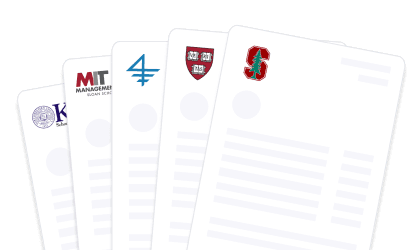
Join a free event
Learn from top coaches and industry experts in live, interactive sessions you can join for free.
Table of Contents
Most students spend hours crafting the perfect story for their college admissions essay, also known as a college admission essay, carefully choosing the right experience, theme, or moment to highlight. But many overlook something just as important: the format. A well-formatted essay isn’t just easier to read; it signals attention to detail, an ability to follow directions, and respect for the admissions officer’s time. In a process where hundreds of essays are reviewed daily, poor formatting can distract from the message and weaken an otherwise strong application.
This guide outlines exactly how to format a college application essay correctly, and what to avoid, so the story is clear, the structure supports it, and the presentation reinforces the strength of the applicant.
What a College Essay Is and Why Format Matters
Your college admissions essay, also called the personal statement, is not just a writing assignment. A typical college application essay is a personal statement of about 500-650 words, designed to highlight your unique qualities and experiences to enhance your application. It’s the only part of your college application where you control the story. It’s where you move beyond test scores and GPA to show who you are, what you value, and how you think.
This isn’t just about content, it’s also about delivery. Admissions officers read dozens of essays per day. If your essay is poorly formatted, hard to read, or looks like you didn’t follow directions, it reflects directly on your application. That kind of friction, bad spacing, inconsistent font, and missing paragraph breaks can pull focus from your message and hurt your credibility. While there is a general structure to follow, the exact format can vary depending on each college's specific instructions and requirements.
A clean, professional format helps your writing land the way you intended. It makes your essay easier to process, more enjoyable to read, and more likely to make an impact. It also shows the reader that you respect the writing process, understand instructions, and take the application seriously. In short: The way your essay looks matters just as much as what it says.
Key Essay Format Guidelines Admissions Officers Expect
Generally, essays for college follow a standard structure with an introduction, a lengthier body, and a conclusion. Formatting your college application essay isn’t optional; it’s part of what admissions officers use to evaluate your ability to follow directions and present ideas clearly. Generally, essays for college include an opening paragraph, a lengthier body, and a closing paragraph. A poorly formatted personal statement can come across as rushed, careless, or hard to read. But a well-organized format makes your story easier to follow and helps your content shine.
Length and Word Count Rules
Most application systems provide a strict word limit. The Common App essay requires a minimum of 250 words and allows up to 650 words. The Coalition Application offers the same upper limit. For University of California schools, each PIQ (Personal Insight Question) response is capped at 350 words.
Going over the limit can cause your essay to be cut off, especially if you’re pasting it into a text box. Submitting something too short can be just as risky. It may signal that you didn’t take the prompt seriously or that you lacked meaningful content to share. In both cases, you reduce your chances of submitting a well-crafted essay that resonates.
Your goal should be to use most of the space available without padding. If you’ve written something strong and it lands at 630 words, you’re right where you need to be. Don’t feel the need to stretch to 650 just to “fill space.” Likewise, avoid stopping at 300 words unless you’ve clearly answered the essay prompt and shown depth. A well-crafted essay could make a significant difference in your application if you use the available word count wisely.
Tracking your word count throughout the writing process can help prevent last-minute cuts. Before submitting, always double-check the limit for each school and make sure your essay fits.
Font, Spacing, and Margins
Stick to basic, readable formatting that shows you understand academic standards. Use 12-point font in a clean, professional typeface like Times New Roman or Arial. Margins should be one inch on all sides. Spacing should be either 1.5-spaced or double, depending on what the application portal specifies.
This format mirrors what most students will use in college writing, which is why admissions committees prefer it. Submitting a single-spaced wall of text or using a strange font makes your essay harder to read and easier to skip over.
When submitting through the Common App or any other text box, paste your essay early in the process and use the preview feature. These boxes sometimes strip out formatting like paragraph breaks, leading to a messy final product. Always check the visual appearance before hitting submit.
Title, Headers, and Styling
Most college admissions essays don’t need a title unless a school specifically asks for one. Titles can waste valuable word count, and in most cases, they aren’t expected.
Avoid stylizing your essay with bold, underline, or italics unless you’re quoting something or writing dialogue. Even then, it’s better to rely on sentence structure and clarity to create emphasis. Overusing styling tools can make your writing look inconsistent or immature. Also, don’t include your name, date, or school information in a header or footer unless explicitly requested. The application already tracks that information. Adding it yourself can come across as trying to make your essay look longer or more formal than it needs to be.
The goal is to present a clean, readable college essay template that reflects the same standards you'll be expected to follow in college. Strong formatting isn’t a substitute for a good story, but it’s a simple way to show discipline, effort, and attention to detail, traits that every admissions officer values.
How to Start Writing an Effective Application Essay
Writing a college application essay is not something you want to rush. Most weak essays don’t fail because of bad ideas; they fall apart because they were started too late, written too fast, or didn’t follow the basic instructions. Here’s how to approach the writing process in a way that gives your essay the best chance of standing out. Below, you'll find tips for essay writing to help you get started and improve your college application essay.
Use these tips to write an impactful essay that will strengthen your application and leave a lasting impression on the admissions committee.
Begin the Writing Process Early
Start your essay as early as the summer before your senior year. This gives you time to brainstorm, test different topics, and revise without pressure. Writing late in the fall, especially right before deadlines, leads to rushed drafts and shallow reflection. If you give yourself enough time, you can explore different angles, experiment with structure, and build a well-crafted essay that’s clear and thoughtful.
Early writing also leaves room for meaningful feedback. Whether it’s a teacher, parent, or college student, having someone else read your draft is much more productive when you’re not racing against a deadline.
Understand the Prompt and Instructions
Before you write anything, read the essay prompt carefully. Essay prompts typically give broad latitude, but they also come with expectations. Some schools ask about a challenge, some want you to reflect on identity or values, and others simply say, “share your story.”
Don’t guess what the prompt is asking; think about your response and match it to the actual question. If the prompt has a specific word limit, formatting requirement, or topic constraint, follow it exactly. Ignoring instructions, even small ones, can hurt how your application is viewed by admissions committees.
Create a Strong Opener That Hooks the Reader
Your opening sentence matters more than you think. Admissions officers are reading hundreds of essays. If your first few lines don’t catch their attention, they may lose focus or move on.
A good opener does two things: It sets the tone, and it introduces a reason to keep reading. You don’t need to shock or impress. Just be real, clear, and intentional. Some strong ways to begin include:
- Quoting something relevant, but only if it ties directly to your story
- Telling a short anecdote that sets up the main theme
- Introducing a specific moment or image that leads into the essay
For example, opening with “I used to think I wanted to be a doctor because of Grey’s Anatomy” is personal, clear, and sets up a direction. It’s better than starting with a generic line like “Ever since I was young, I have always loved helping people.”
Expert Tip: The goal is to interest an admissions officer, not confuse or overwhelm them. Avoid vague statements or abstract ideas. Be specific, direct, and true to your experience.
Structuring Your Essay Like a Story
Every college application essay needs a clear structure. Understanding the structure of an essay for college admission is crucial, as it helps you present your personality and experiences in a way that stands out to admissions officers. If your story is hard to follow, it won’t matter how good your ideas are. A typical college essay format follows three basic parts: an introduction, a body, and a conclusion.
The introduction sets up the idea or theme. The body shows what happened or what you learned. The conclusion brings it all together. Most personal statements land somewhere between 4–6 paragraphs total. But structure isn’t just about organizing paragraphs. It’s about how you shape your story. When using a narrative structure, crafting a riveting story that fulfills the essay prompt can make your essay memorable and help you stand out from other applicants. And there are two structure types that work especially well for college admissions essays: Narrative and Montage.
Read: 5 Pro Tips for Writing Successful College Application Essays
Narrative Structure
Narrative structure works well if you’ve experienced real challenges or defining moments. This style follows a story arc. You start with a problem or turning point, show how you responded, and end with what it taught you. It’s especially effective for students who have faced challenges and overcome obstacles, such as mental health struggles, and want to highlight these experiences in their essays. It’s a good fit for students who’ve dealt with obstacles, major decisions, or growth through discomfort.
The structure usually follows this flow:
- What happened: Set up the situation or challenge.
- What you did: Describe your actions, choices, or responses.
- What you learned: Show how it changed your thinking or helped you grow.
This structure works because it builds momentum. It’s easy to follow and helps the admissions officer understand not just what happened, but how you handled it. If you’ve experienced something that shaped your perspective, this is often the right structure to use.
Read: How to End a College Essay (With Examples)
Montage Structure
Montage structure works best when you don’t have one central story but want to highlight different sides of who you are. Instead of one timeline, you build your essay around a theme, value, or idea. Each paragraph shows a different moment or experience that connects to that theme. This approach allows you to showcase qualities beyond your academic credentials, such as your character, personal experiences, and unique traits.
For example, you might use curiosity as your thread and include scenes from different parts of your life, fixing a broken radio, researching mushrooms in biology class, and asking your grandfather about war stories. These moments don’t need to be connected by time, but they should all reveal something consistent about you.
Montage is a good fit for students who want to explore multiple interests or show how different pieces of their identity come together. It also works for students who haven’t faced a major hardship but still have a lot to say.
What NOT to Do When Formatting or Writing Your Essay
A compelling college application essay isn’t just about telling your story; it’s also about avoiding the missteps that weaken it. These are some of the most common mistakes students make when writing and formatting their college admissions essays, and how to avoid them.
Don’t Reuse Old Essays
It can seem efficient to fit previously written essays into new applications, especially if you’re applying to a lot of schools. But this approach rarely works. Avoid using the mold of another college's essay for a new application, as each school has its own essay prompt and expectations. Reusing content often leads to generic or disconnected writing. Final pieces that are generic, unfocused, or confusing tend to feel like filler, and admissions officers can tell.
Start fresh for each prompt. Even if your core story stays the same, adjust the framing, reflection, and conclusion to match what that school is actually asking. Recycled essays may save time, but they reduce your chances of writing a well-crafted essay that actually answers the question.
Don’t Use Language That Isn’t Yours
Some students try to impress admissions committees by using overly formal vocabulary, complex sentence structures, or academic jargon. This usually backfires. If you wouldn’t use a word in conversation, don’t use it in your essay.
Stay true to your voice. Write like you’re talking to someone smart and thoughtful, like a coach or mentor. That doesn’t mean being casual or sloppy. It means using clear, honest language that sounds like you. Flex your creative muscles, but don’t pretend to be someone else.
Don’t Include Off-Limit Content
There’s a difference between being personal and being overly intimate and particular. Your essay should reveal something about who you are, not retell your resume, list awards, or go too deep into sensitive topics that you aren’t ready to explore. Avoid repeating achievements or academic accolades that are already listed in your application. The essay is where you show context, values, and thought, not where you stack more credentials.
Also, avoid personal details and controversial topics that don’t connect clearly to your growth, identity, or readiness for college. That doesn’t mean avoiding tough topics entirely. Health struggles can create powerful stories if handled with care. The key is to focus less on what happened and more on how you responded, what you learned, and how it shaped your perspective.
If you’re not sure whether your topic crosses the line, ask a teacher, parent, or college student you trust. They can give you an honest opinion on whether your draft feels relevant, clear, and appropriate for a college admissions audience.
Read: How to Craft the Perfect "Why Do You Want to Go to College" Essay
Edit, Proofread, and Ask for Feedback
Even the strongest college application essay can fall flat if it’s riddled with typos and awkward grammar. Before submission, it is essential to edit and proofread your essay to catch errors, improve clarity, and ensure overall quality. Editing and proofreading are not optional steps; they are part of the writing process that separates a rushed draft from a well-crafted essay.
Be sure to finish the final draft and make certain it is polished and error-free before submitting your application.
Read It Aloud
Reading your college essay aloud is one of the simplest and most effective editing techniques. It forces you to slow down and hear how each sentence sounds. Awkward phrasing, repetitive words, or sudden shifts in tone become obvious when you hear them rather than skim silently. If you stumble while reading, it’s a sign that something needs rewriting.
Step Away and Re-Read
Don’t edit immediately after finishing a draft. Put the essay aside for at least a day, ideally a few. Returning with fresh eyes makes errors stand out, whether they’re small grammar mistakes or structural problems like a weak transition or a confusing final paragraph.
Ask for Help
An outside perspective is invaluable. Share your essay with someone you trust, such as a teacher, parent, or college student who’s been through the process. They can point out sections that feel unclear, overly formal, or disconnected from the essay prompt. Just remember: you want feedback, not a total rewrite. Your voice needs to remain authentic.
Use Tools, But Don’t Rely on Them
Spell checkers and grammar tools like Grammarly are helpful, but they don’t replace a human review. Automated tools often miss nuance, tone issues, or formatting errors, especially when pasting into a text box like the Common App essay field. Always do a manual proofread before submission, and double-check your word count and note any last adjustments needed.
Submitting Your Essay the Right Way
How you submit your college admissions essay is just as important as how you write it. Formatting errors, broken paragraphs, or the wrong file type can make your essay harder to read, or worse, cause it to display incorrectly in the application system. Follow the instructions exactly and give your submission one last full review before hitting send.
If You’re Uploading a Word or PDF Document
If the school allows or asks you to upload your essay as a file, keep it simple. Use a standard filename that includes your first and last name. Something like Jane_Smith_CollegeEssay.docx works well.
Save the file as a Word document or a PDF, depending on what the school requests. PDFs are usually safer since they preserve your formatting, but always check the application’s exact requirements. Before uploading, open the file and scroll through it to make sure your formatting, double spacing, margins, and paragraph breaks are consistent from start to finish.
Avoid fancy headers, footers, or title pages. Just include the essay, formatted cleanly and clearly.
If You’re Pasting Into a Text Box
Many students use the Common App or other platforms where they paste their essay into a text box. These boxes can strip out formatting like paragraph indentations or italics. That’s why it’s important to paste your essay early in the process and use the preview feature.
After pasting, re-read your entire essay in the preview view. Look for spacing issues, missing line breaks, or sections that got cut off. If anything looks off, fix it before final submission.
Stick to plain text formatting. Don’t rely on styling like bold or underline unless you know the application will support it. And once again, double-check the word count after pasting; sometimes characters and formatting tags can shift your count slightly.
Whether you’re uploading or pasting, treat the final step with the same focus as your writing. Clean presentation helps your application essay land the way you intended.
Expert Tips to Help Your Essay Stand Out
Choose a Topic That’s Genuinely Important to You
The best college admissions essays focus on something real. Your topic should matter to you, not because it’s impressive, but because it helped shape how you think or who you are. Authenticity stands out. Trying to guess what admissions officers want to hear usually leads to a flat or forced tone.
Don’t Try to Impress, Be Honest Instead
Avoid writing for approval. A compelling college application essay doesn’t need big achievements or dramatic events. What matters most is that your story feels honest and personal. Admissions committees are looking for reflection, not perfection.
Eliminate Filler and Vague Statements
Every sentence in your college essay should serve a purpose. If it doesn’t add depth, context, or insight, cut it. General statements about wanting to help others, be a leader, or pursue success often feel empty without specifics. Stick to details that show who you are through real experiences.
Avoid Repeating Your Resume
Your application essay is not the place to list personal achievements or repeat items from your activities section. Use the essay to share something the rest of the application doesn’t cover, something personal, thoughtful, and meaningful. That’s what makes a well-crafted essay stand out.
Write Something That’s Easy to Remember
Your goal is to write an essay that shows your mindset, your values, or your growth, not just your qualifications. Writing essays for college is about adding dimension to your application. A strong essay tells a story the reader won’t forget.
Read: How to Write a Conclusion for a College Application Essay
The Bottom Line
A well-formatted college admissions essay does more than look clean; it shows maturity, attention to detail, and respect for the reader’s time. In a competitive review process, poor formatting can distract from your story, while strong formatting helps your message land clearly and effectively.
Stick to standard fonts, spacing, and structure, avoid recycled content, and focus on honest reflection over trying to impress. When your formatting supports your content, admissions officers can focus on what really matters: who you are and what you bring to their campus.
Work With a Coach to Perfect Your Essay
The best essays come from strong ideas, clear formatting, and honest reflection. If you want feedback or help shaping your draft, Leland coaches can support you through every stage, from brainstorming to editing. Get matched with an expert admissions coach today. Browse College Essay Coaches here.
Read these next:
- 4 Tips to Elevate Your College Essay
- What Looks Good on College Applications? 6 Tips to Make Your Application Stand Out
- Tips for Time Management in College
- Top Questions to Ask a College Admissions Officer
- The 10 Best College Admissions Consultants
FAQs About College Essay Format
What is the format for a college essay?
- Use 12-point Times New Roman or Arial, one-inch margins, and double-spaced lines unless told otherwise. Keep your college essay between 250–650 words and organize it into clear paragraphs. These guidelines apply to most essays for college admission.
Are college essays MLA or APA?
- College application essays do not follow MLA or APA. Just use standard formatting, no citations, title pages, or headers unless a school specifically asks for them.
What are the 5 D’s of college essays?
- The “5 D’s” refer to death, divorce, depression, disease, and disaster. These topics are hard to write well and should only be used if they clearly show personal growth and self-awareness. Mental health struggles can create challenges in academic or personal life, and addressing how you overcame them in essays for college admission can demonstrate resilience.
What format does college use for essays?
- Colleges expect clean formatting: 12-point font, one-inch margins, and consistent spacing. Submit as a Word document, PDF, or paste into a text box, depending on the platform.
Browse hundreds of expert coaches
Leland coaches have helped thousands of people achieve their goals. A dedicated mentor can make all the difference.


























